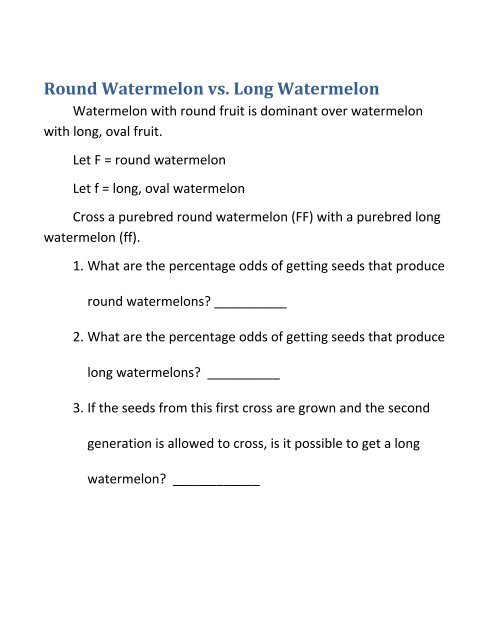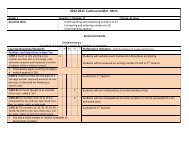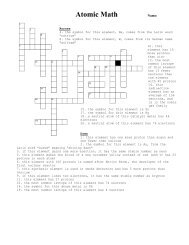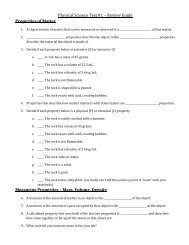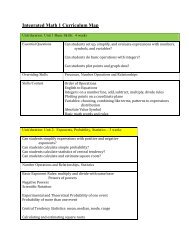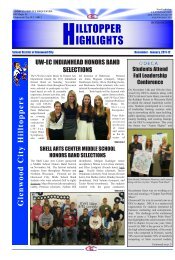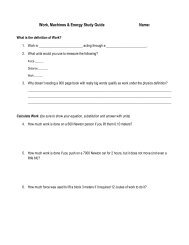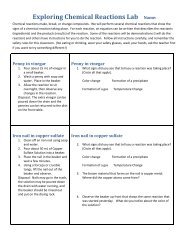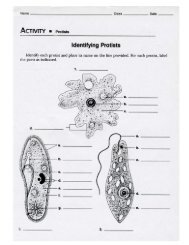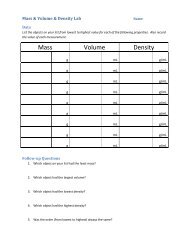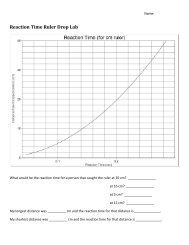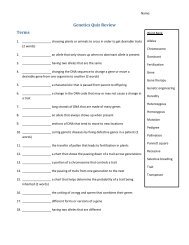Practice with Punnett Squares
Practice with Punnett Squares
Practice with Punnett Squares
Create successful ePaper yourself
Turn your PDF publications into a flip-book with our unique Google optimized e-Paper software.
Round Watermelon vs. Long WatermelonWatermelon <strong>with</strong> round fruit is dominant over watermelon<strong>with</strong> long, oval fruit.Let F = round watermelonLet f = long, oval watermelonCross a purebred round watermelon (FF) <strong>with</strong> a purebred longwatermelon (ff).1. What are the percentage odds of getting seeds that produceround watermelons? __________2. What are the percentage odds of getting seeds that producelong watermelons? __________3. If the seeds from this first cross are grown and the secondgeneration is allowed to cross, is it possible to get a longwatermelon? ____________
Curly hair vs. Straight HairCurly Hair is usually dominant over straight hair in humans.Let H = curly hairLet h = straight hairCross a mother and father who both have curly hair, but hadone parent <strong>with</strong> straight hair. (Hint: they are both heterozygous.)4. What are the percent odds of having a child <strong>with</strong> curly hair?_______________5. What are the percent odds of having a child <strong>with</strong> straighthair? ________________6. Would curly hair or straight hair be the trait that “skips ageneration”? __________________
Long and Short EyelashesLong eyelashes are dominant over short eyelashes.Assign a letter for the dominant and recessive alleles of thistrait.Cross a mother who is Heterozygous <strong>with</strong> a father that isHomozygous recessive for this trait.7. What are the percent odds that a child will be born <strong>with</strong>short eyelashes? __________
Dimples vs. No dimplesDimpled cheeks are dominant over cheeks <strong>with</strong>out dimples.Assign a letter for the dominant and recessive alleles of thistrait.Cross a father who is Heterozygous <strong>with</strong> a mother that isHomozygous dominant for this trait.8. What are the percent odds of getting a child that isHeterozygous for dimpled cheeks? _________9. What are the percent odds of getting a child that isHomozygous dominant? ____________10. What are the percent odds of getting a child that isHomozygous recessive? ____________11. Would a child that is Homozygous recessive have dimplesor not? _____________
Sun Sneezer vs. Non-Sun SneezerAlthough it is estimated to affect only 30% of the population,the tendency to sneeze when exposed to bright light is a dominanttrait.Assign a capital letter for Sun Sneezers and the same letter, butlower case for Non-sun sneezers.Cross a dad that is a Sun Sneezer from a long line of sunsneezers (homozygous dominant) <strong>with</strong> a mom that is a non-sunsneezer (homozygous recessive).12. What are the percent odds of having a child that is a sunsneezer?_______________13. What are the percent odds of having a child that is a nonsneezer?_______________
Sickle Cell Disease(you can read about sickle cell disease in your textbook on pageB110-B111)Let R = normal round red blood cellsLet R 0 = sickle-shaped red blood cellsCross two parents that are both heterozygous for sickle celldisease (RR 0 ).14. What are the percent odds of getting a child that has sicklecell disease (R 0 R 0 )? ____________15. What are the percent odds of getting a child that is also acarrier of sickle cell disease (RR 0 )? ___________
Blood Type(you can read about ABO blood type on page B111 of your textbook)Cross a person <strong>with</strong> type O blood (ii) <strong>with</strong> a person that hastype AB blood (I A I B ).16. What are the percent odds of getting a child <strong>with</strong> each ofthe following blood types:Type O (ii)___________Type A (I A I A or I A i) ___________Type B (I B I B or I B i) ___________Type AB (I A I B )___________17. Using the chart on page B111 of your textbook, can aperson <strong>with</strong> type AB blood donate to a person <strong>with</strong> type Oblood? _______18. What type(s) of blood can a person who is Type O receive?____________________
Wet Ear Wax vs. Dry Ear WaxAlthough it is nearly absent in Asian populations, wet, sticky earwax is dominant over dry, flaky ear wax.Let E = wet ear waxLet e = dry ear waxSome American servicemen who fought in Vietnam fatheredchildren <strong>with</strong> Vietnamese women during the war. Cross a father<strong>with</strong> wet ear wax (assume he is EE) <strong>with</strong> a woman that had dry earwax (ee).19. What are the percent odds that the baby will have wet earwax? ___________Wet ear wax is associated <strong>with</strong> a specific type of body odor and, moreseriously, seems to be linked to an increased risk for a specific type ofbreast cancer. This type of breast cancer was not known in nativeVietnamese before the war, but has been on the rise in generationsborn after the Vietnam War. Scientists are working on a screening testthat looks at the ear wax and body odor of women as an indicator oftheir chances of developing this type of cancer.20. Could a Vietnamese boy <strong>with</strong> an American father pass onthe allele for wet ear wax (and perhaps breast cancer) to hisdaughters? ___________________
Answers to numbered questions:1. 100%2. 0%3. Yes (25% of the next generation will be long)4. 75%5. 25%6. Straight hair7. 50%8. 50%9. 50%10. 0%11. Not12. 100%13. 0%14. 25%15. 50%16. Type O – 0%, Type A – 50%, Type B – 50%, Type AB – 0%17. No18. Only Type O19. 100%20. Yes (The boy would probably be a carrier, so his daughters may have a 50% chance of gettingthe wet ear wax gene from him.)


